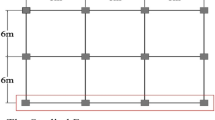Abstract
The aim of a well designed construction in a seismic area is to avoid the collapse of buildings during major earthquakes. Up to now, this damage is expressed by the absence of plastic collapse, which takes into account the notion of the cinematic ductility in terms of demand and capacity. The ductility capacity must satisfy a certain level imposed by codes, without considering the duration of the strong motion and thus, number of plastic incursions and the fatigue phenomenon effects in the dissipative zones of the structure. Analytical investigation was carried out for six steel moment resisting frames with different dynamic parameters, subjected to six earthquakes with various characteristics. In total, thirty six cases were studied with a non linear dynamic analysis to assess the factors that affect the damage distribution of structures. Hereafter, the main results of this analysis are presented.
Similar content being viewed by others
References
Arroyo, D. and Ordaz, M. (2007). “Hysteretic energy demands for SDOF systems subjected to narrow band earthquake ground motions. Applications to the lake bed zone of Mexico City.” J. Earthq. Eng., Vol. 11, No. 2, pp. 147–165.
Bojórquez, E., Reyes-Salazar, A., Terán-Gilmore, A., and Ruiz, S. E. (2010). “Energy-based damage index for steel structures.” Steel and Composite Structures, Vol. 10, No. 4, pp. 343–360.
Bojórquez, E., Ruiz, S. E., and Terán-Gilmore, A. (2008). “Reliabilitybased evaluation of steel structures using energy concepts.” Eng. Struct., Vol. 30, No. 6, pp. 1745–1759.
Bolt, B. A. (1969). “Duration of strong motion.” Proc. 4th World Conf. Earthquake Eng., Santiago, Chilie, pp. 1304–1315.
Brozzetti, J. and Chabrolin, B. (1986). “Méthode de comptage des charges de fatigue.” Construction Métallique, No. 1.
C. G. S. (2003). Algerian seismic code, RPA99/version 2003, National Earthquake Engineering Centre, DTR-BC-2.48, Ministry of Housing and Urban Planning Algiers, Algeria.
C. G. S. (2007). Steel code for buildings design and construction, C.C.M 97, National Earthquake Engineering Centre, DTR-BC-2.44, Ministry of Housing and Urban Planning Algiers, Algeria.
Carlson, A. (1999). Three-dimensional nonlinear inelastic analysis of steel moment-frame buildings damaged by earthquake excitations, Technical report EERL 1999-02, Earthquake Engineering Research Laboratory, California Institute of Technology, Pasadena, California.
Choi, H. and Kim, J. (2006). “Energy-based seismic design of bucklingrestrained braced frames using hysteretic energy spectrum.” Eng. Struct., Vol. 28, No. 2, pp. 304–311.
Chopra, A. (2001). Dynamics of structures, Theory and Applications to Earthquake Engineering, Prentice-Hall, Englewood Cliffs, NJ.
Daali, M. and Korol, R. M. (1995). “Low cycle fatigue damage assessment in steel beams.” Struct. Engrg. and Mech., Vol. 3, No. 4, pp. 341–358.
Federal Emergency Management Agency, FEMA, (2000). Recommended seismic design criteria for new steel moment-frame buildings, FEMA-350, Federal Emergency Management Agency, Washington, D.C.
Gorl, E. and Link. M. (2001). “Identification of damage parameters of full-scale steel structure damaged by seismic loading.” Smart Mater. Struct., Vol. 10, No. 3, pp. 459–465.
Hancock, J. and Bommer, J. J. (2006). “A state-of-knowledge review of the influence of strong-motion duration on structural damage.” Earthq. Spectra, Vol. 22, No. 3, pp. 827–845.
Kanaan, A. E. and Powell, G. H. (1973). A general purpose computer for dynamic analysis of inelastic plane structures, Users Manual of DRAIN2D, University of California.
Krawinkler, H. and Zohrei M. (1983). “Cumulative damage in steel structures subjected to earthquake ground motions.” Comp. and Struct., Vol. 16, Nos. 1–4, pp. 531–541.
Krishnan S., Ji, C., Komatitsch, D., and Tromp, J. August (2006). “Case studies of damage to tall steel moment-frame buildings in southern California during large San Andreas earthquakes.” Bulletin of the Seismological Society of America, Vol. 96, No. 4A, pp. 1523–1537.
Krishnan, S. (2003). Three-dimensional nonlinear analysis of tall irregular steel buildings subject to strong ground motion, Technical Report EERL 2003-01, Earthquake Engineering Research Laboratory, California Institute of Technology, Pasadena, California.
Mazzolani, F. M. and Piluso, V. (1996). Theory and design of seismic resistant steel frames, E & FN SPON, London, England.
Miner, M. A. (1945). “Cumulative damage in fatigue.” Journal of Applied Mechanics, Transactions of the American Society of Mechanical Engineers, ASME, Vol. 67, No. A, pp. 159–164.
Page, R. A., Boore, D. M., Joyner, W. B., and Caulter, H. W. (1972). Ground motion values for use in the seismic design of the Trans-Alaska pipeline system, USGS Circular 672.
Powell, G. H. and Allahabadi, R. (1988). “Seismic damage prediction by deterministic methods: Concepts and procedures.” Earthquake Engrg. and Struct. Dyn., Vol. 16, No. 5, pp. 719–734.
Soize, C. (1979). “Cumul de fatigue sous sollicitations aléatoires.” Construction Métallique CTICM, Vol. 16, No. 4, pp. 3–22.
Sorace, S. M. (1998). “Seismic damage assessment of steel frames.” Journal of Structural Engineering, Vol. 124, No. 5, pp. 531–540.
Terán-Gilmore, A. and Jirsa, J. O. (2007). “Energy demands for seismic design against low-cycle fatigue.” Earthq. Eng. Struct. Dynam., Vol. 36, No. 3, pp. 383–404.
Wilson, E. and Habibullah, A. (2004). Extended 3D analysis of building systems nonlinear version 8.45, Computers and Structures, Inc. Berkeley, California.
Author information
Authors and Affiliations
Corresponding author
Rights and permissions
About this article
Cite this article
Mehani, Y., Bechtoula, H., Kibboua, A. et al. Damage quantification of steel moment resisting frames using ductility parameters. KSCE J Civ Eng 17, 1394–1402 (2013). https://doi.org/10.1007/s12205-013-0121-7
Received:
Revised:
Accepted:
Published:
Issue Date:
DOI: https://doi.org/10.1007/s12205-013-0121-7




